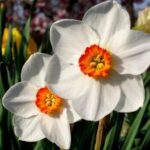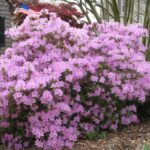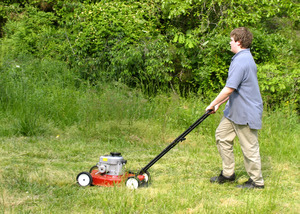Black-eyed Susan, otherwise called “Goldstrum” – this flower is one of the simple, old-fashioned flowers that have been around for years. The Black-eyed Susan quickly fills in an area, but you don’t have to worry about it taking over. It grows well in zones 3 through 11, and it will beautify your garden spot like a ray of sunshine. They start to bloom in mid-summer and continue into the fall with blooms that are yellow or orange with a dark center. Black-eyed Susan are perfect to grow among other flowers or shrubs. Not only do these flowers look pretty, they attract birds and butterflies. Depending on the variety you choose, they can grow between 2 and 10 feet tall and 1.5 to 3 feet wide.
Bluestar
Bluestar is tolerant of almost any soil condition, so that makes it the perfect choice for any garden. It grows well whether the ground is soggy or hard clay. It does not care if it has full sun or part shade. The amsonia has clusters of powder blue, star-shaped flowers. The blooming period is from mid spring to late spring. Even when the flowers are gone, this plant remains a showpiece with its mound of green foliage. In the fall, the leaves turn golden, continuing the show until the season ends. This plant also attracts butterflies. Depending on the variety, this plant will grow from one to four feet tall, and will be one to four feet in width.
Asters
Asters, (Aster Novae-angliae), are another plant that has been around a long time, because of its simple beauty. They resemble a daisy and blooms in a wide variety of colors during the fall season. You can choose from pink, rose, white, lavender, and purple. They live in zones 3 through 9. They will grow between one and five feet tall, and are one to four feet wide. Asters are another perennial flower that attracts butterflies. Some Asters will bloom during the summer months, so you can have several months of color.
Baptisia
Baptisia grows in zones 3 through 9. This is a native plant to the prairie and grows its roots down deep, even in clay. It can survive through most droughts, because of the deep taproot. It has a wide range of blooms from blue, white, yellow, and purple. The flowers form on long plant spikes and resemble pea-like blooms. The flowering season is late spring, but even when the flowers go to seed, this plant is still showy and the seedpods turn black. It is a sun loving plant, but can tolerate some shade. It grows between two and three feet tall and is the same in width. This is a beautiful plant and is the perfect choice for poor soils or ones that have clay. Just be sure to choose a place where you will want it to stay and grow. Once these perennial plants are established, they are not easy transplants.
Coreopsis
Coreopsis is a wonderful perennial plant for the garden. This plant will spread to make it a great ground cover when nothing else will grow. Coreopsis loves the sun and the leathery foliage and yellow flowers resemble a daisy. I love growing Coreopsis. They have bright little flowers. Their very presence brightens any area where they are planted. You can usually find butterflies around this little plant. Although yellow is the primary color, you can also find Coreopsis in a few other colors. There are different shades of yellow and pink, and there are bi-color flowers. The blooming period for this plant is early summer to mid-summer, but if you deadhead it, it will continue to bloom for a longer period. This perennial grows in zones 3 through 9 and grows from one to three feet wide.
Purple Coneflower
The Purple Coneflower, (Echinacea) is another wonderful plant to grow that is reminiscence of prairie times. Growing in zones 3 through 9 it has many varieties. Today, they even have it in hybrid form with colors ranging from pink, orange, burgundy, red and white. This flower is so easy to grow and it is great for attracting birds and butterflies to your garden area. If the flowers are left to go to seed, the goldfinches will come for a feast. This perennial is another flower that resembles the daisy with drooping petals. It prefers full sun and grows between two to four feet tall and one to two feet in width.
Sea Holly
Sea Holly is as cool a looking plant as its name. It has jagged leaves and the flowers are clusters of steel-blue shaped balls. This plant gets a bad reputation because it is a relative to thistles, but do not worry, this plant does not spread as they do. What is nice about this plant is that it will survive the worst conditions. The taproot runs deep into the ground, so it is hard to transplant once it is established. Unlike other perennials, this one is easy to grow from seed and it grows in zones 2 through 10. It is one to six feet tall and one to three feet wide. If you do not want this plant to spread, simply remove the flowers before they go to seed, otherwise they can self-seed back.
Perennial Geranuim
Perennial Geranium or cranesbill is a plant that is great to cover the ground. It does not mind clay soil and grows in full sun to part shade. Depending on the variety you choose, some will bloom in the spring, but others will bloom throughout the summer. The leaves change color in the fall and are hardy in zones 3 through 9. The perennial geranium is one of the longest blooming plants in the garden, as it will bloom for months. The flowers are saucer-shaped and the foliage is lobed shaped. They grow from eight inches to four feet tall and one to four feet wide.
False Sunflower
If you want a flower, that is heat and drought resistant, then the False Sunflower (Heliopsis) is the plant for you. This perennial grows well in zones 3 through 9. The False Sunflower can be confused with the perennial sunflower, but they have several advantages. They are more compact, so they will not flop over and they bloom earlier than the other sunflowers. Many varieties have either a single, semi-double or double row of flower petals and they bloom over many weeks. They grow in zones 3 through 9 and grow three to six feet tall and one to two feet wide. If you want vigorous growth, you need to divide the plants every couple of years.
Just because you have poor soil does not mean you have to have a colorless yard. Far from it. Try planting some of these plants and be amazed at how well your yard will take on color.





